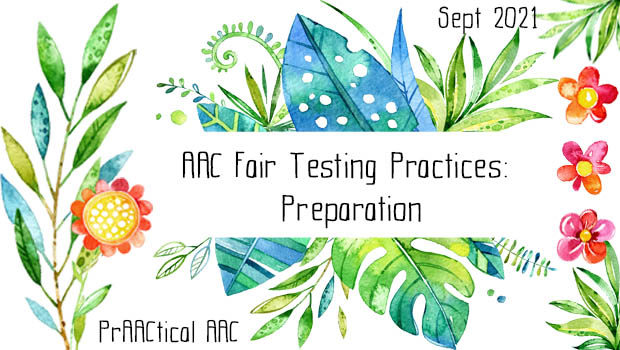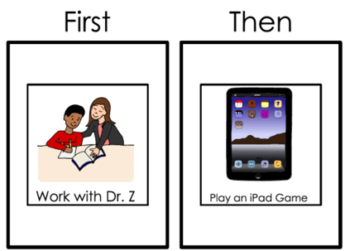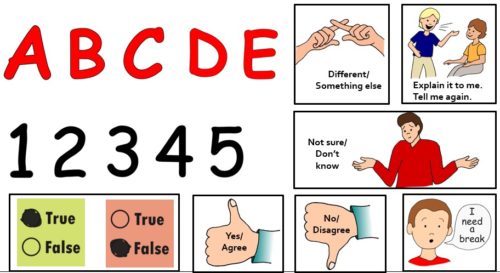AAC Fair Testing Practices: Preparation

In an earlier post, we talked about the difficulties that people who use AAC experience when they have to participate in tests or other assessments for educational or therapeutic purposes. (You can see that post here.) One approach to addressing these challenges is for key stakeholders to come together and develop a set of guidelines that teachers, therapists, and others can use when they need to administer an assessment.
Today, we’ll look at some of the guiding questions that teams can use to develop these Fair Testing Practices. The idea here is that AAC users, families, professionals, and other team members can come together to discuss a number of specific issues regarding preparation, materials, means of answering questions, etc. Later in the series, we’ll talk about ways to facilitate meaningful participation by individuals who use AAC but are still developing their communication and language skills. For the time being, though, let’s explore some of the guiding questions for the team to address.
Preparation, both for the professionals who will administer the assessment and for the individual who uses AAC, plays an important role in this process.
TOPIC 1: What preparation does the student need in order to participate in the assessment so that we are more likely to be testing knowledge & skills as opposed to the impact of their disability?
- Many AAC users have limited experience with assessments, particularly those that were administered in appropriate ways. As a result, they may not have had an opportunity to develop the same kind of test-taking skills that many of their peers have.
- Can test-taking skills be taught? Absolutely! We can teach test-taking skills using the processes that help students learn school routines and many other things. Depending on the individual, we might do a task analysis and teach the skills for participating in tests using strategies like backward and forward chaining.
- One important caveat: Students have to develop their test-taking skills before we put those into practice with assessments that we will actually score. You didn’t take your driving test when you first got behind the steering wheel and neither did I. We had some instruction. We practiced. And we practiced some more. Only after we gained sufficient skills did we go to the Division of Motor Vehicles to take our test.
TOPIC 2: How can we ensure that the student understands the expectations and requirements of the test?
- It’s not just inexperience that makes testing difficult for many AAC users. In some cases, they have language or cognitive challenges that are barriers to understanding the directions. In other cases, they may need help understanding what is expected of them during the assessment process.
- Visual supports (such as picture schedules) and social narratives can be helpful in both situations.


- Here’s a sample script for a social narrative we used to help the student understand what was going to take place during the assessment.
- Sample: “I have speech with Mr. Joseph. We play games and do lots of fun things. Sometime soon, I will go to Mr. Joseph’s room to do something different. When I get there, he will probably have a schedule. It might look a lot like the schedules we use when I go for speech. I will try to do everything on the schedule. It will have things like pointing to pictures, talking, and answering questions. It’s okay if I don’t know the answer. I will not get in trouble and no one will be mad at me. I will try my best. If I need a break, I can tell Mr. Joseph. I can ask for help at any time. When I ask for help, Mr. Joseph will help me figure it out. When I finish everything on the schedule, it will probably be time to go back to class. Mr. Joseph will be really happy that I tried my best. Mrs. Santiago will probably be very proud of me. Mom and Dad will be proud of me, too.”
TOPIC 3: Does the student need to be oriented to new vocabulary on the AAC device prior to testing? Does the student need new vocabulary through signs, gestures, or unaided signals?
- Depending on the nature of the test and the purpose for which we are administering it, there may be a need to introduce new vocabulary or do a refresher on some existing words that the student rarely uses.
- In AAC, we honor multimodal communication, and that is no less important in test situations. As a team, consider the various modalities that the student uses for communication and how those will be addressed. For example, with a student who does some signing and enjoys that mode of expression, we might teach the signs for True and False so that they can respond efficiently in a preferred modality.
- In some situations, it might make sense to create a test-taking screen on their SGD or create an array with messages that would be helpful when participating in assessments.

In the next post, we will explore additional topics that can help teams develop Fair Testing Practices for the AAC users in their lives. In the meantime, if you have tips, suggestions, or questions, use the comment area below to share your thoughts.
See you next time!
Filed under: Featured Posts, PrAACtical Thinking
This post was written by Carole Zangari

1 Comment
For someone with little exposure to AAC, these are areas that I never thought of. All information is helpful and very valid for helping these students have success in their educational journey.